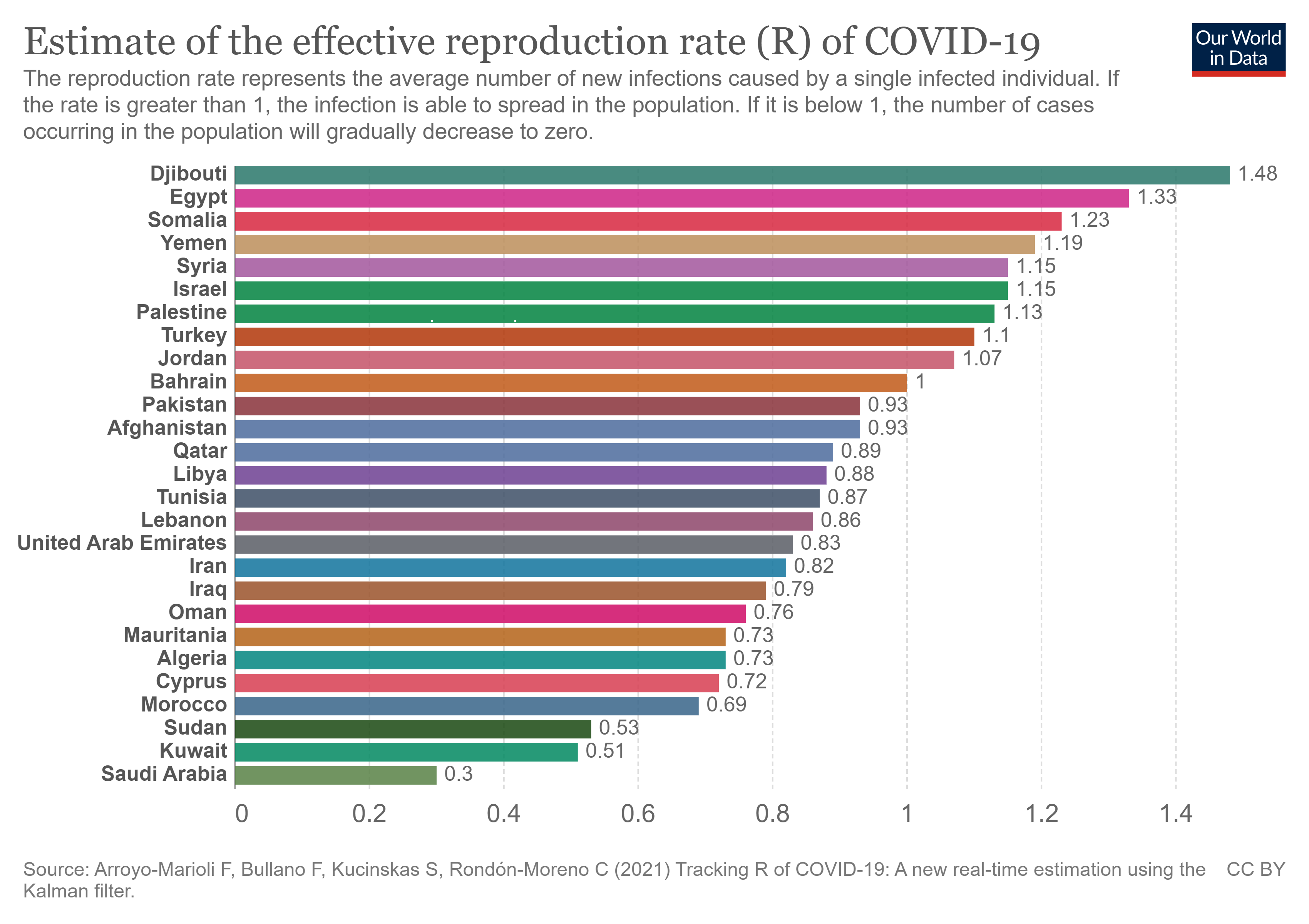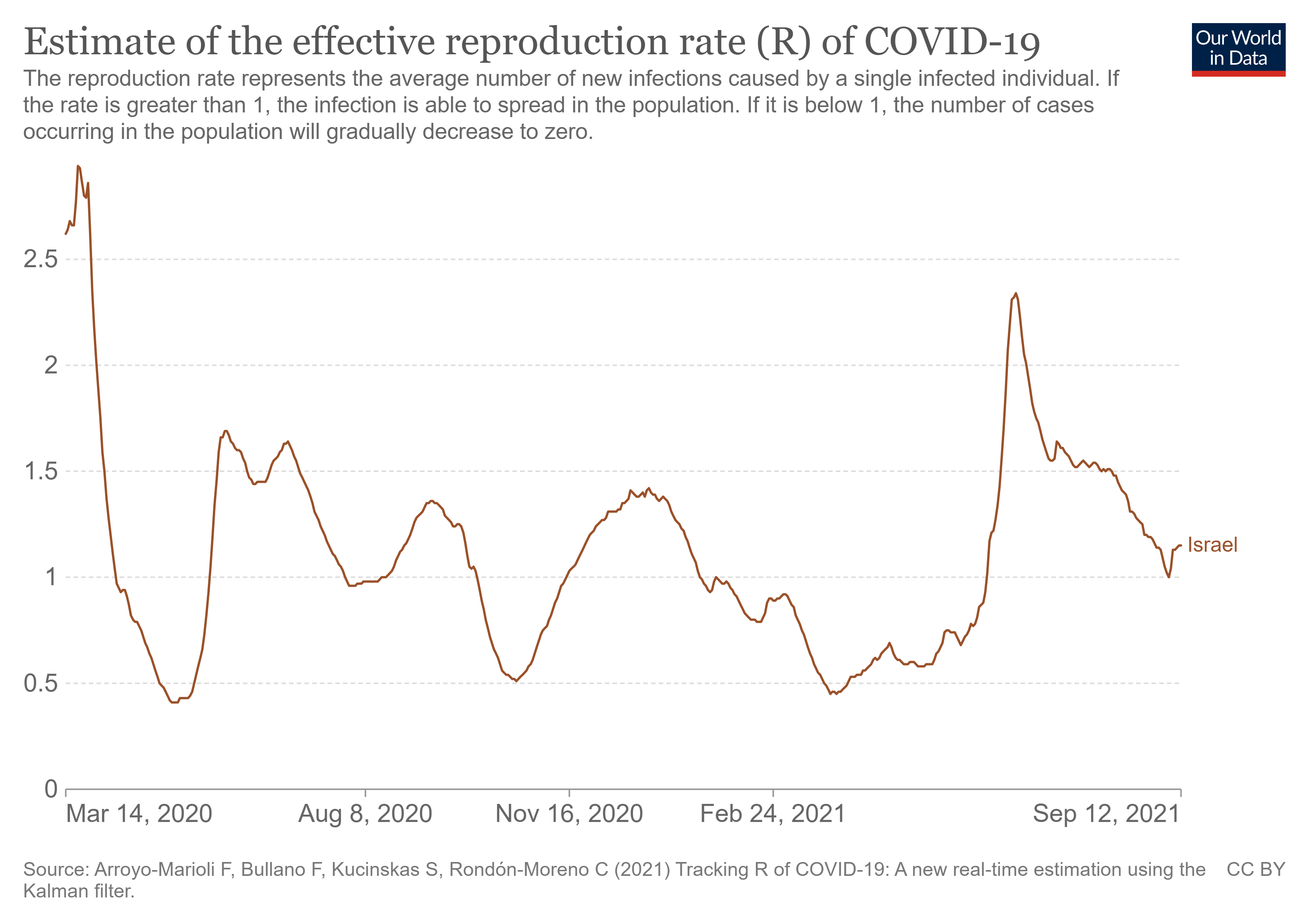An infectious disease’s basic reproduction number (referred to as R0 or R-naught) is a measure of its ability to spread in an unprotected population. Take into consideration factors such as vaccination, immunity acquired by recovering from the disease, the use of masks, and social distancing, all of which reduce susceptibility to infection, and you get the disease’s effective reproduction number, called Rt or Re.
The effective reproduction number (for the sake of simplicity, we’ll call it R for the rest of this article) is the average number of new infections caused by a single infected individual. If R is 2, for example, an infected person will pass the disease on to an average of two other people before recovering, or dying, from the disease.
When R is greater than 1, the infection is able to spread in the population. Measles, perhaps the most contagious disease on earth, has a basic R number (in an unprotected population) of 12 to 18. COVID-19’s delta variant has a basic R number of 5 to 8. But measures such as vaccination and wearing masks can reduce the effective R value significantly.
To achieve herd immunity, it is necessary, but not sufficient, for R to drop below 1. If enough of the population acquires immunity, for example with a successful vaccination program, R will stay below 1 and the number of cases occurring in the population will gradually decrease to zero. But the threshold for herd immunity may require unachievably high levels of vaccination in the case of COVID-19, in which case, even after the pandemic is over, the disease will remain endemic, like influenza.
Achieving an R value below 1 represents a crucial milestone in beating back the coronavirus pandemic.
COVID-19 across the entire globe had an effective R value of 3.55 (measured as a seven-day rolling average) on January 27, 2020. It dropped to 0.57 by Feb. 21, 2020, bringing hope that the pandemic might be short-lived, but then shot back up to 2.11 on March 19 of that year. Since then, it has hovered right around 1, and currently (as of Sept. 12, 2021) measures 0.92.
The spread of coronavirus in Singapore shows the highest current R value in the world – 1.94. But around two weeks ago, on Sept. 1, Grenada’s R value was measured to be 3.07. Peak R over the course of the pandemic was registered by Turkey, where the virus hit the dizzying R value of 5.17 on March 20, 2020.
On the low end of the scale, a few countries have achieved R values at or near 0, but in most cases these seem to be anomalies based on low testing rates and erroneous data, not reflective of the actual spread of the disease. The ostensible R champion is Tanzania, where R supposedly hit 0 on May 27, 2020 and has remained 0 ever since. Other current low-R countries include Nicaragua, the Central African Republic, and Cameroon, which report values between 0.02 and 0.15.
In the Middle East and North Africa region, Djibouti reports the highest current R value (1.48), despite showing only 12.54 daily new cases per million population. (For comparison, the United States, where R is currently 0.97, counts around 515 daily new cases per million population.) Ranking just below Djibouti in our region is Egypt, where R is currently 1.33. The top five in the MENA region also include Somalia (1.24), Yemen (1.19), and, tying for fifth place, Syria and Israel (1.15). Saudi Arabia shows the lowest current R value in the MENA region, at 0.3.

A graph of Israel’s R values resembles the roller-coaster that the country has ridden over the course of the pandemic. After hitting a peak of 2.94 on March 20, 2020, R plummeted to 0.41 on May 6, 2020. It hasn’t been that low since. Its second-highest R value (2.34) was recorded on June 23, 2021. By Sept. 6, it reached the all-important value of 1, bringing hope that the country had turned a corner and would soon see the virus retreating. But since then, R has crept back up to 1.15.

Here are the latest COVID-19 numbers for the Middle East and North Africa as of 9:15 am Greenwich Mean Time (UTC±0) on Wednesday.
| Country | Confirmed Cases | Deaths | Recovered | Active Cases |
| Afghanistan | 154,283 | 7,174 | 118,764 | 28,345 |
| Algeria | 200,528 | 5,614 | 137,052 | 57,862 |
| Bahrain | 273,916 | 1,388 | 271,590 | 938 |
| Cyprus | 116,494 | 534 | 90,755 | 25,205 |
| Djibouti | 11,897 | 157 | 11,656 | 84 |
| Egypt | 293,951 | 16,895 | 247,450 | 29,606 |
| Iran | 5,340,656 | 115,167 | 4,627,027 | 598,462 |
| Iraq | 1,959,369 | 21,596 | 1,834,670 | 103,103 |
| Israel | 1,194,783 | 7,438 | 1,102,263 | 85,082 |
| Jordan | 809,443 | 10,568 | 786,558 | 12,317 |
| Kuwait | 410,901 | 2,434 | 407,396 | 1,071 |
| Lebanon | 614,688 | 8,210 | 574,802 | 31,676 |
| Libya | 326,370 | 4,457 | 240,685 | 81,228 |
| Mauritania | 35,042 | 760 | 33,158 | 1,124 |
| Morocco | 908,349 | 13,683 | 866,064 | 28,602 |
| Oman | 303,268 | 4,090 | 293,498 | 5,680 |
| Pakistan | 1,212,809 | 26,938 | 1,108,339 | 77,532 |
| Palestinian Territories | 374,768 | 3,837 | 338,398 | 32,533 |
| Qatar | 234,895 | 604 | 232,425 | 1,866 |
| Saudi Arabia | 546,163 | 8,633 | 535,190 | 2,340 |
| Somalia | 18,568 | 1,032 | 9,066 | 8,470 |
| Sudan | 37,995 | 2,873 | 31,916 | 3,206 |
| Syria | 29,805 | 2,090 | 22,837 | 4,878 |
| Tunisia | 695,406 | 24,274 | 667,201 | 3,931 |
| Turkey | 6,710,666 | 60,393 | 6,201,905 | 448,368 |
| United Arab Emirates | 730,135 | 2,066 | 721,367 | 6,702 |
| Yemen | 8,502 | 1,608 | 5,288 | 1,606 |
| Total | 23,553,650 | 354,513 | 21,517,320 | 1,681,817 |